Hybrid Adsorption-Compression Systems for Air Conditioning in Efficient Buildings: Design through Validated Dynamic Models
Abstract
:1. Introduction
- thermophysical models, making use of the constitutive equations of the system, that can be solved through a numerical or iterative approach;
- black box models, that are based on a completely empirical approach;
- grey box models, combining a semi-empirical approach with the physical models for one or more components.
2. System Description
- if solar energy is not available, cold energy is produced directly from the vapour compression chiller, that can be directly connected to the dry cooler.
- If there is a mismatch between the solar availability and user demand, in order to exploit the renewable source, cold energy can be produced using the cascade system and stored in a sensible or latent cold storage.
- During winter, the heating demand of the building can be satisfied by direct connection to the solar collectors (if solar energy is available) or by the heat pump.
- Domestic hot water can be supplied by the solar collectors, coupled to a small water buffer or a back-up system (i.e., existing gas boiler in case of retrofitting).
3. Model Description: Adsorption Module
3.1. Generalities and Assumptions
- all components are lumped models with uniform properties;
- the heat transfer fluid inside the heat exchangers is incompressible;
- pressure drops inside the heat exchangers are constant;
- gravity is neglected;
- the thermal masses of vacuum vessels are neglected;
- there are no heat losses to the environment;
- there is no direct heat exchanger due to conduction between the components;
- there are no inert gases inside the closed volume.
3.2. Heat Exchange Model
3.3. Adsorption Model
3.4. VLE Model
4. Model Description: Compression Chiller
4.1. Assumptions
- All components are lumped, with constant properties.
- One dimensional flow in each component with uniform velocity profile.
- No pressure loss inside the heat exchangers. Instead, lumped pressure loss models in both refrigerant and water pipelines were employed.
- Heat losses to the ambient are neglected for every component.
- Neglected dynamics for the compressor.
- Constant electromechanical efficiency of the compressor motor.
- Existence of subcooling and superheating at the outlet of the condenser and the evaporator respectively.
- Heat transfer coefficients vary with their nominal values according to the mass flow rate to nominal mass flow rate ratio.
4.2. Heat Exchangers Models
4.3. Compressor Model
4.4. Thermostatic Expansion Valve model (TEXV)
5. Model Validation
5.1. Adsorption Module
5.2. Compression Chiller
6. Hybrid System Integrated Model: Results
- the temperature of the heat source is higher than a user-defined value (in the present case, 75 °C);
- the temperature in the chilled water circuit (evaporator secondary circuit) of the adsorption unit is lower than Tamb − 5 °C, the condition under which direct connection of the compression unit with the external sinks becomes more favorable.
6.1. Results in Dynamic Conditions
6.2. Sensitivity Analysis
6.3. Applications of the Model
- (a)
- lookup tables, useful for example as input data in a TRNSYS or Energy Plus model for annual energy evaluation or to test different control strategies at system level;
- (b)
- analytical equations, correlating the EER/COP to the operating conditions. Such equations can be re-used in a simplified model to be applied for optimization of control strategies.
7. Conclusions
Author Contributions
Acknowledgments
Conflicts of Interest
Nomenclature
| A | Adsorption potential, kJ |
| b | Equilibrium constant, kg/J |
| cp | Specific heat, kJ/kg K |
| D | Diffusion coefficient, m2/ s |
| e | efficiency |
| E | Adsorption equilibrium coefficient, kJ/kg |
| h | Specific enthalpy, kJ/kg |
| H | Enthalpy, kJ |
| K | Flow coefficient, bar-1/2 kg/s |
| L | Length, m |
| m | Mass, kg |
| Mass flow, kg/s | |
| N | Adsorption equilibrium exponent |
| p | Pressure, Pa |
| P | Electric power, kW |
| Q | Energy, kJ |
| Thermal Power, kW | |
| r | Radius, m |
| R | Universal gas constant, kJ/(kg K) |
| rpm | Rotations, 1/min |
| RS | Relative size, kW/kW |
| S | Surface, m2 |
| slip | Motor slip factor |
| t | Time, s |
| T | Temperature, °C |
| U | Internal energy, kJ |
| V | Volume, m3 |
| w | Uptake, kg/kg |
| W | Work, kW |
| w0 | Equilibrium constant, kg/kg |
| x | Vapour quality |
| y | Control signal |
| Greek letters | |
| α | Heat transfer coefficient, W/(m2K) |
| β | Adsorption rate constant, 1/s |
| ε | Heat Exchanger effectiveness |
| Hybrid/compression chiller pressure ratio, bar/bar | |
| ρ | Density, kg/m3 |
| γ | Mean Void Fraction |
| Subscripts | |
| ads | adsorption |
| amb | ambient |
| c | channel |
| comp | compressor |
| cond | condenser |
| ev | evaporator |
| el | electric |
| eq | equilibrium |
| hyb | hybrid |
| in | inlet |
| is | isentropic |
| l | liquid |
| mot | motor |
| nom | nominal |
| out | outlet |
| ref | refrigerant |
| s | swept |
| sat | saturation |
| sf | secondary fluid |
| sorb | adsorbent |
| sync | synchronous |
| th | thermal |
| v | vapour |
| vol | volumetric |
| Abbreviations | |
| CV | Control Volume |
| EER | Energy Efficiency Ratio, kW/kW |
| HEX | Heat EXchanger |
| HTF | Heat Transfer Fluid |
| NTU | Number of Heat Transfer Units |
| SB | SubCooled |
| SH | SuperHeated |
| TEXV | Thermostatic EXpansion Valve |
| TP | Two Phase |
Appendix A
| Phase | A [kJ/kg] | w0 [kg/kg] | E [kJ/kg] | n |
|---|---|---|---|---|
| Adsorption | <450 | 0.31 | 388.8 | 3 |
| >450 | 265 | 0.8 | ||
| Desorption | <200 | 0.3 | 400 | 3.5 |
| >200 < 305 | 810 | 1.8 | ||
| >305 < 410 | 410 | 6 | ||
| >410 | 410 | 1.2 |
| Parameter | Value | Source |
|---|---|---|
| 120 W m−2 K−1 | [40,63] | |
| 103 J kg−1 | [80] | |
| D | 3.3 ·10−10 m2 s−1 | Experimental data fitting parameter |
| hads | 2.6 ·106 J kg−1 | [61] |
| fv | 10−5 m s | [34] |
| fp | 0.1 kg s−1 | [34] |
| msorb | 20 kg | Provided by the component manufacturer |
| mmetal,ads | 24.5 kg | Provided by the component manufacturer |
| VHTF,ads | 10.5 l | Provided by the component manufacturer |
| 0.5 kg s−1 | Provided by the component manufacturer | |
| mref | 6 l | Provided by the component manufacturer |
| αHTF,cond | 3000 W m−2 K−1 | Calculated from experimental data reported in [16] |
| αHTF,evap | 1500 W m−2 K−1 | Calculated from experimental data reported in [16] |
| αref,cond | 1000 W m−2 K−1 | Calculated from experimental data reported in [16] |
| αref,evap | 500 W m−2 K−1 | Calculated from experimental data reported in [16] |
| mmetal,cond | 25 kg | Provided by the component manufacturer |
| mmetal,evap | 25 kg | Provided by the component manufacturer |
| VHTF,cond | 3.8 l | Provided by the component manufacturer |
| VHTF,evap | 3.8 l | Provided by the component manufacturer |
| 1.8 kg s−1 | Provided by the component manufacturer | |
| 0.5 kg s−1 | Provided by the component manufacturer |
Appendix B
| Parameter | Description | Value | Source | |
|---|---|---|---|---|
| Heat Exchanger Models | ||||
| Evaporator | Condenser | |||
| Number of plates | 24 | 30 | HEX Manufacturer | |
| Cross sectional area of a channel | 2.08·10−4 | 2.08·10−4 | HEX Manufacturer | |
| Heat transfer area | 1.32 | 1.68 | HEX Manufacturer | |
| Total wall mass | 12 | 16 | HEX Manufacturer | |
| Wall specific heat capacity | 490 | 490 | HEX Manufacturer | |
| Refrigerant nominal flow rate for the refrigerant | 0.078 | 0.078 | Chiller Manufacturer | |
| Water nominal flow rate | 0.63 | 0.78 | Chiller Manufacturer | |
| Nominal heat transfer coef. SH CV | 450 | 500 | Calculated | |
| Nominal heat transfer coef. TP CV | 5000 | 3400 | Calculated | |
| Nominal heat transfer coef. in SB CV | − | 500 | Calculated | |
| Nominal heat transfer coef. for water | 7100 | 8400 | Calculated | |
| Mean Void Fraction | 0.96 | 0.8 | Calculated | |
| Nominal lumped pressure drop for the whole refrigerant line | 0.2 | 0.2 | Chiller Manufacturer | |
| Nominal lumped pressure drop on the water side | 0.196 | 0.12 | Chiller Manufacturer | |
| Compressor Model | ||||
| (cm³/rev) | Compressor Swept Volume | 51 | Chiller Manufacturer | |
| Magnetic poles of compressor motor | 2 | Chiller Manufacturer | ||
| Slip factor of compressor motor | 0.029 | Chiller Manufacturer | ||
| Volumetric efficiency on nominal conditions | 0.945 | Calculated | ||
| Isentropic on nominal conditions | 0.683 | Calculated | ||
| TEXV Model | ||||
| (mm2) | TEXV full open cross sectional area | 2.25 | Calculated | |
| TEXV Set point | 4.2 | Standard Value | ||
References
- European Commission. Directive 2010/31/EU of the European Parliament and of the Council of 19 May 2010 on the Energy Performance of Buildings; European Commission: Brussels, Belgium, 2010. [Google Scholar]
- Gullbrekken, L.; Grynning, S.; Gaarder, J.; Gullbrekken, L.; Grynning, S.; Gaarder, J.E. Thermal Performance of Insulated Constructions—Experimental Studies. Buildings 2019, 9, 49. [Google Scholar] [CrossRef]
- Rony, R.; Yang, H.; Krishnan, S.; Song, J.; Rony, R.U.; Yang, H.; Krishnan, S.; Song, J. Recent Advances in Transcritical CO2 (R744) Heat Pump System: A Review. Energies 2019, 12, 457. [Google Scholar] [CrossRef]
- Bee, E.; Prada, A.; Baggio, P.; Bee, E.; Prada, A.; Baggio, P. Demand-Side Management of Air-Source Heat Pump and Photovoltaic Systems for Heating Applications in the Italian Context. Environments 2018, 5, 132. [Google Scholar] [CrossRef]
- Dengiz, T.; Jochem, P.; Fichtner, W. Demand response with heuristic control strategies for modulating heat pumps. Appl. Energy 2019, 238, 1346–1360. [Google Scholar] [CrossRef]
- Pospíšil, J.; Špiláček, M.; Kudela, L. Potential of predictive control for improvement of seasonal coefficient of performance of air source heat pump in Central European climate zone. Energy 2018, 154, 415–423. [Google Scholar] [CrossRef]
- Millar, M.-A.; Burnside, N.; Yu, Z. District Heating Challenges for the UK. Energies 2019, 12, 310. [Google Scholar] [CrossRef]
- Zhang, L.; Li, F.; Sun, B.; Zhang, C.; Zhang, L.; Li, F.; Sun, B.; Zhang, C. Integrated Optimization Design of Combined Cooling, Heating, and Power System Coupled with Solar and Biomass Energy. Energies 2019, 12, 687. [Google Scholar] [CrossRef]
- IEA-RETD; de Vos, R.; Sawin, J. Chapter Seven—Heating and Cooling Policies. In READy: Renewable Energy Action on Deployment; Elsevier Inc.: Amsterdam, The Netherlands, 2013; pp. 115–135. ISBN 9780124055193. [Google Scholar]
- Underwood, C.P.; Royapoor, M.; Sturm, B. Parametric modelling of domestic air-source heat pumps. Energy Build. 2017, 139, 578–589. [Google Scholar] [CrossRef]
- Chokchai, S.; Chotpantarat, S.; Takashima, I.; Uchida, Y.; Widiatmojo, A.; Yasukawa, K.; Charusiri, P.; Chokchai, S.; Chotpantarat, S.; Takashima, I.; et al. A Pilot Study on Geothermal Heat Pump (GHP) Use for Cooling Operations, and on GHP Site Selection in Tropical Regions Based on a Case Study in Thailand. Energies 2018, 11, 2356. [Google Scholar] [CrossRef]
- Henning, H.-M.; Döll, J. Solar Systems for Heating and Cooling of Buildings. Energy Procedia 2012, 30, 633–653. [Google Scholar] [CrossRef]
- Lazzarin, R.M.; Noro, M. Past, present, future of solar cooling: Technical and economical considerations. Sol. Energy 2018, 172, 2–13. [Google Scholar] [CrossRef]
- Shirazi, A.; Taylor, R.A.; Morrison, G.L.; White, S.D. Solar-powered absorption chillers: A comprehensive and critical review. Energy Convers. Manag. 2018, 171, 59–81. [Google Scholar] [CrossRef]
- Ge, T.S.; Wang, R.Z.; Xu, Z.Y.; Pan, Q.W.; Du, S.; Chen, X.M.; Ma, T.; Wu, X.N.; Sun, X.L.; Chen, J.F. Solar heating and cooling: Present and future development. Renew. Energy 2018, 126, 1126–1140. [Google Scholar] [CrossRef]
- Vasta, S.; Palomba, V.; La Rosa, D.; Mittelbach, W. Adsorption-compression cascade cycles: An experimental study. Energy Convers. Manag. 2018, 156, 365–375. [Google Scholar] [CrossRef]
- Sangi, R.; Jahangiri, P.; Müller, D. A combined moving boundary and discretized approach for dynamic modeling and simulation of geothermal heat pump systems. Therm. Sci. Eng. Prog. 2019, 9, 215–234. [Google Scholar] [CrossRef]
- Prestipino, M.; Palomba, V.; Vasta, S.; Freni, A.; Galvagno, A. A Simulation Tool to Evaluate the Feasibility of a gasification-I.C.E. System to Produce Heat and Power for Industrial Applications. Energy Procedia 2016, 101, 1256–1263. [Google Scholar] [CrossRef]
- Palomba, V.; Ferraro, M.; Frazzica, A.; Vasta, S.; Sergi, F.; Antonucci, V. Experimental and numerical analysis of a SOFC-CHP system with adsorption and hybrid chillers for telecommunication applications. Appl. Energy 2018, 216, 620–633. [Google Scholar] [CrossRef]
- Calise, F.; Ferruzzi, G.; Vanoli, L. Transient simulation of polygeneration systems based on PEM fuel cells and solar heating and cooling technologies. Energy 2012, 41, 18–30. [Google Scholar] [CrossRef]
- Palomba, V.; Vasta, S.; Freni, A.; Pan, Q.; Wang, R.; Zhai, X. Increasing the share of renewables through adsorption solar cooling: A validated case study. Renew. Energy 2016, 110, 126–140. [Google Scholar] [CrossRef]
- Buonomano, A.; Calise, F.; Palombo, A. Solar heating and cooling systems by absorption and adsorption chillers driven by stationary and concentrating photovoltaic/thermal solar collectors: Modelling and simulation. Renew. Sustain. Energy Rev. 2018, 82, 1874–1908. [Google Scholar] [CrossRef]
- Frazzica, A.; Briguglio, N.; Sapienza, A.; Freni, A.; Brunaccini, G.; Antonucci, V.; Ferraro, M. Analysis of different heat pumping technologies integrating small scale solid oxide fuel cell system for more efficient building heating systems. Int. J. Hydrogen Energy 2015, 40, 14746–14756. [Google Scholar] [CrossRef]
- Chargui, R.; Sammouda, H. Modeling of a residential house coupled with a dual source heat pump using TRNSYS software. Energy Convers. Manag. 2014, 81, 384–399. [Google Scholar] [CrossRef]
- Salvalai, G. Implementation and validation of simplified heat pump model in IDA-ICE energy simulation environment. Energy Build. 2012, 49, 132–141. [Google Scholar] [CrossRef]
- Dorer, V.; Weber, A. Energy and CO2 emissions performance assessment of residential micro-cogeneration systems with dynamic whole-building simulation programs. Energy Convers. Manag. 2009, 50, 648–657. [Google Scholar] [CrossRef]
- Pagliarini, G.; Corradi, C.; Rainieri, S. Hospital CHCP system optimization assisted by TRNSYS building energy simulation tool. Appl. Therm. Eng. 2012, 44, 150–158. [Google Scholar] [CrossRef]
- Alibabaei, N.; Fung, A.S.; Raahemifar, K. Development of Matlab-TRNSYS co-simulator for applying predictive strategy planning models on residential house HVAC system. Energy Build. 2016, 128, 81–98. [Google Scholar] [CrossRef]
- Bava, F.; Furbo, S. Development and validation of a detailed TRNSYS-Matlab model for large solar collector fields for district heating applications. Energy 2017, 135, 698–708. [Google Scholar] [CrossRef]
- Calise, F. Design of a hybrid polygeneration system with solar collectors and a Solid Oxide Fuel Cell: Dynamic simulation and economic assessment. Int. J. Hydrogen Energy 2011, 36, 6128–6150. [Google Scholar] [CrossRef]
- El-Baz, W.; Tzscheutschler, P.; Wagner, U. Experimental Study and Modeling of Ground-Source Heat Pumps with Combi-Storage in Buildings. Energies 2018, 11, 1174. [Google Scholar] [CrossRef]
- Graber, M.; Kosowski, K.; Richter, C.; Tegethoff, W. Modelling of heat pumps with an object-oriented model library for thermodynamic systems. Math. Comput. Model. Dyn. Syst. 2010, 16, 195–209. [Google Scholar] [CrossRef]
- Dechesne, B.; Gendebien, S.; Lemort, V.; Bertagnolio, S. Experimental investigation and dynamic modeling of an air-to-water residential heat pump with vapor injection and variable speed scroll compressor. In Proceedings of the 12th IEA H, Rotterdam, The Netherlands, 15–18 May 2017; pp. 1–12. [Google Scholar]
- Schicktanz, M.; Núñez, T. Modelling of an adsorption chiller for dynamic system simulation. Int. J. Refrig. 2009, 32, 588–595. [Google Scholar] [CrossRef]
- Deutz, K.R.; Charles, G.-L.; Cauret, O.; Rullière, R.; Haberschill, P. Detailed and dynamic variable speed air source heat pump water heater model: Combining a zonal tank model approach with a grey box heat pump model. Int. J. Refrig. 2018, 92, 55–69. [Google Scholar] [CrossRef]
- Leonzio, G. Mathematical model of absorption and hybrid heat pump. Chin. J. Chem. Eng. 2017, 25, 1492–1504. [Google Scholar] [CrossRef]
- Mohammed, R.H.; Mesalhy, O.; Elsayed, M.L.; Chow, L.C. Assessment of numerical models in the evaluation of adsorption cooling system performance. Int. J. Refrig. 2018, 99, 166–175. [Google Scholar] [CrossRef]
- Bau, U.; Baumgärtner, N.; Seiler, J.; Lanzerath, F.; Kirches, C.; Bardow, A. Optimal Operation of Adsorption Chillers: First Implementation and Experimental Evaluation of a Nonlinear Model-Predictive-Control Strategy. Appl. Therm. Eng. 2018, 149, 1503–1521. [Google Scholar] [CrossRef]
- Bau, U.; Hoseinpoori, P.; Graf, S.; Schreiber, H.; Lanzerath, F.; Kirches, C.; Bardow, A. Dynamic optimisation of adsorber-bed designs ensuring optimal control. Appl. Therm. Eng. 2017, 125, 1565–1576. [Google Scholar] [CrossRef]
- Freni, A.; Maggio, G.; Cipitì, F.; Aristov, Y.I. Simulation of water sorption dynamics in adsorption chillers: One, two and four layers of loose silica grains. Appl. Therm. Eng. 2012, 44, 69–77. [Google Scholar] [CrossRef]
- Darkwa, K.; Ianakiev, A.; O’Callaghan, P.W. Modelling and simulation of adsorption process in a fluidised bed thermochemical energy reactor. Appl. Therm. Eng. 2006, 26, 838–845. [Google Scholar] [CrossRef]
- Youssef, P.G.; Mahmoud, S.M.; Al-Dadah, R.K. Numerical simulation of combined adsorption desalination and cooling cycles with integrated evaporator/condenser. Desalination 2016, 392, 14–24. [Google Scholar] [CrossRef]
- Kim, D.-S.; Chang, Y.-S.; Lee, D.-Y. Modelling of an adsorption chiller with adsorbent−coated heat exchangers: Feasibility of a polymer−water adsorption chiller. Energy 2018, 164, 1044–1061. [Google Scholar] [CrossRef]
- Papoutsis, E.G.; Koronaki, I.P.; Papaefthimiou, V.D. Numerical simulation and parametric study of different types of solar cooling systems under Mediterranean climatic conditions. Energy Build. 2017, 138, 601–611. [Google Scholar] [CrossRef]
- Alahmer, A.; Wang, X.; Al-Rbaihat, R.; Amanul Alam, K.C.; Saha, B.B. Performance evaluation of a solar adsorption chiller under different climatic conditions. Appl. Energy 2016, 175, 293–304. [Google Scholar] [CrossRef]
- Reda, A.M.; Ali, A.H.H.; Morsy, M.G.; Taha, I.S. Design optimization of a residential scale solar driven adsorption cooling system in upper Egypt based. Energy Build. 2016, 130, 843–856. [Google Scholar] [CrossRef]
- Vasta, S.; Palomba, V.; Frazzica, A.; Di Bella, G.; Freni, A. Techno-Economic Analysis of Solar Cooling Systems for Residential Buildings in Italy. J. Sol. Energy Eng. Trans. ASME 2016, 138, 031005. [Google Scholar] [CrossRef]
- Fernandes, M.S.; Brites, G.J.V.N.; Costa, J.J.; Gaspar, A.R.; Costa, V.A.F. A thermal energy storage system provided with an adsorption module—Dynamic modeling and viability study. Energy Convers. Manag. 2016, 126, 548–560. [Google Scholar] [CrossRef]
- Ling, J.; Qiao, H.; Alabdulkarem, A.; Aute, V.; Radermacher, R. Modelica-based Heat Pump Model for Transient and Steady-State Simulation Using Low-GWP Refrigerants. In Proceedings of the 15th International Refrigeration and Air Conditioning Conference at Purdue, West Lafayette, IN, USA, 14–17 July 2014; pp. 1–9. [Google Scholar]
- Mortada, S.; Zoughaib, A.; Clodic, D.; Arzano-Daurelle, C. Dynamic modeling of an integrated air-to-air heat pump using Modelica. Int. J. Refrig. 2012, 35, 1335–1348. [Google Scholar] [CrossRef]
- Tangwe, S.; Simon, M.; Meyer, E. Mathematical modeling and simulation application to visualize the performance of retrofit heat pump water heater under first hour heating rating. Renew. Energy 2014, 72, 203–211. [Google Scholar] [CrossRef]
- Saloux, E.; Sorin, M.; Teyssedou, A. Modeling the exergy performance of heat pump systems without using refrigerant thermodynamic properties. Energy Build. 2016, 112, 69–79. [Google Scholar] [CrossRef]
- Ruschenburg, J.; Ćutić, T.; Herkel, S. Validation of a black-box heat pump simulation model by means of field test results from five installations. Energy Build. 2014, 84, 506–515. [Google Scholar] [CrossRef]
- Fritzson, P.A. Introduction to Modeling and Simulation of Technical and Physical Systems with Modelica by Fritzson, Peter A; John Wiley & Sons, Inc.: Hoboken, NJ, USA, 2011; ISBN 978-1-118-01068-6. [Google Scholar]
- Systemes, D. Dymola. Available online: https://www.3ds.com/products-services/catia/products/dymola/ (accessed on 1 February 2019).
- Quoilin, S.; Desideri, A.; Wronski, J.; Bell, I.; Lemort, V. ThermoCycle: A Modelica library for the simulation of thermodynamic systems. In Proceedings of the 10th International Modelica Conference, Lund, Sweden, 10–12 March 2014. [Google Scholar]
- Bell, I.H.; Wronski, J.; Quoilin, S.; Lemort, V. Pure and Pseudo-pure Fluid Thermophysical Property Evaluation and the Open-Source Thermophysical Property Library CoolProp. Ind. Eng. Chem. Res. 2014, 53, 2498–2508. [Google Scholar] [CrossRef] [PubMed]
- Bau, U.; Lanzerath, F.; Gräber, M.; Graf, S.; Schreiber, H.; Thielen, N.; Bardow, A. Adsorption energy systems library—Modeling adsorption based chillers, heat pumps, thermal storages and desiccant systems. In Proceedings of the 10th International Modelica Conference, Lund, Sweden, 10–12 March 2014. [Google Scholar]
- Desideri, A.; Dechesne, B.; Wronski, J.; van den Broek, M.; Gusev, S.; Lemort, V.; Quoilin, S.; Desideri, A.; Dechesne, B.; Wronski, J.; et al. Comparison of Moving Boundary and Finite-Volume Heat Exchanger Models in the Modelica Language. Energies 2016, 9, 339. [Google Scholar] [CrossRef]
- Sah, R.P.; Choudhury, B.; Das, R.K.; Sur, A. An overview of modelling techniques employed for performance simulation of low–grade heat operated adsorption cooling systems. Renew. Sustain. Energy Rev. 2017, 74, 364–376. [Google Scholar] [CrossRef]
- Frazzica, A.; Freni, A. Adsorbent working pairs for solar thermal energy storage in buildings. Renew. Energy 2017, 110, 87–94. [Google Scholar] [CrossRef]
- El-Sharkawy, I.I. On the linear driving force approximation for adsorption cooling applications. Int. J. Refrig. 2011, 34, 667–673. [Google Scholar] [CrossRef]
- Lanzerath, F.; Bau, U.; Seiler, J.; Bardow, A.; Bardow, E. Optimal design of adsorption chillers based on a validated dynamic object-oriented model. Sci. Technol. Built Environ. 2015, 21, 248–257. [Google Scholar] [CrossRef]
- Bendapudi, S.; Braun, J.E.; Groll, E.A. A comparison of moving-boundary and finite-volume formulations for transients in centrifugal chillers Comparaison entre les formulations aux limites mobiles et’ gimes transitoires des aux volumes finis pour les re refroidisseurs centrifuges. Int. J. Refrig. 2008, 31, 1437–1452. [Google Scholar] [CrossRef]
- Li, B.; Alleyne, A.G. A dynamic model of a vapor compression cycle with shut-down and start-up operations. Int. J. Refrig. 2010, 33, 538–552. [Google Scholar] [CrossRef]
- Vaupel, Y.; Huster, W.R.; Holtorf, F.; Mhamdi, A.; Mitsos, A. Analysis and improvement of dynamic heat exchanger models for nominal and start-up operation. Energy 2019, 169, 1191–1201. [Google Scholar] [CrossRef]
- Pangborn, H.; Alleyne, A.G.; Wu, N. A comparison between finite volume and switched moving boundary approaches for dynamic vapor compression system modeling. Int. J. Refrig. 2015, 53, 101–114. [Google Scholar] [CrossRef]
- Willatzen, M.; Pettit, N.B.O.L. A general dynamic simulation model for evaporators and condensers in refrigeration. Part I: Moving-boundary formulation of two-phase flows with heat exchange ´ne´ ral dynamique pour e´ vaporateurs et Mode condenseurs frigorifiques. Partic I: Formul. Int. J. Refrig. 1998, 21, 398–403. [Google Scholar] [CrossRef]
- Butterworth, D. A comparison of some void fraction relationships for co-current gas-liquid flow. Int. J. Multiph. Flow 1975, 1, 845–850. [Google Scholar] [CrossRef]
- I.S. 12900:2005 EN. Refrigerant Compressors. Rating Conditions, Tolerances and Presentation of Manufacturer’s Performance; European Norm: Brussels, Belgium, 2005.
- Graf, S.; Lanzerath, F.; Sapienza, A.; Frazzica, A.; Freni, A.; Bardow, A. Prediction of SCP and COP for adsorption heat pumps and chillers by combining the large-temperature-jump method and dynamic modeling. Appl. Therm. Eng. 2016, 98, 900–909. [Google Scholar] [CrossRef]
- Frazzica, A.; Palomba, V.; Dawoud, B.; Gullì, G.; Brancato, V.; Sapienza, A.; Vasta, S.; Freni, A.; Costa, F.; Restuccia, G. Design, realization and testing of an adsorption refrigerator based on activated carbon/ethanol working pair. Appl. Energy 2016, 174, 15–24. [Google Scholar] [CrossRef]
- Sapienza, A.; Gullì, G.; Calabrese, L.; Palomba, V.; Frazzica, A.; Brancato, V.; La Rosa, D.; Vasta, S.; Freni, A.; Bonaccorsi, L.; et al. An innovative adsorptive chiller prototype based on 3 hybrid coated/granular adsorbers. Appl. Energy 2016, 179, 929–938. [Google Scholar] [CrossRef]
- Sapienza, A.; Santamaria, S.; Frazzica, A.; Freni, A.; Aristov, Y.I. Dynamic study of adsorbers by a new gravimetric version of the Large Temperature Jump method. Appl. Energy 2014, 113, 1244–1251. [Google Scholar] [CrossRef]
- Eurovent Operational Manual for the Certification of Liquid Chilling Packages and Hydronic Heat Pumps; Eurovent Certita Certification S.A.S.: Paris, France, 2018.
- Fong, J.; Edge, J.; Underwood, C.; Tindale, A.; Potter, S.; Du, H.; Fong, J.; Edge, J.; Underwood, C.; Tindale, A.; et al. Application of a New Dynamic Heating System Model Using a Range of Common Control Strategies. Buildings 2016, 6, 23. [Google Scholar] [CrossRef]
- Ascione, F.; Bianco, N.; De Stasio, C.; Mauro, G.M.; Vanoli, G.P. Simulation-based model predictive control by the multi-objective optimization of building energy performance and thermal comfort. Energy Build. 2016, 111, 131–144. [Google Scholar] [CrossRef]
- Hu, X.; Wang, B.; Yang, S.; Short, T.; Zhou, L.; Hu, X.; Wang, B.; Yang, S.; Short, T.; Zhou, L. A Closed-Loop Control Strategy for Air Conditioning Loads to Participate in Demand Response. Energies 2015, 8, 8650–8681. [Google Scholar] [CrossRef]
- Tommasi, L.; Ridouane, H.; Giannakis, G.; Katsigarakis, K.; Lilis, G.; Rovas, D.; De Tommasi, L.; Ridouane, H.; Giannakis, G.; Katsigarakis, K.; et al. Model-Based Comparative Evaluation of Building and District Control-Oriented Energy Retrofit Scenarios. Buildings 2018, 8, 91. [Google Scholar] [CrossRef]
- Sapienza, A.; Velte, A.; Girnik, I.; Frazzica, A.; Füldner, G.; Schnabel, L.; Aristov, Y. “Water—Silica Siogel” working pair for adsorption chillers: Adsorption equilibrium and dynamics. Renew. Energy 2017, 110, 40–46. [Google Scholar] [CrossRef]
- García-Cascales, J.R.; Vera-García, F.; Corberán-Salvador, J.M.; Gonzálvez-Maciá, J. Assessment of boiling and condensation heat transfer correlations in the modelling of plate heat exchangers. Int. J. Refrig. 2007, 30, 1029–1041. [Google Scholar] [CrossRef]
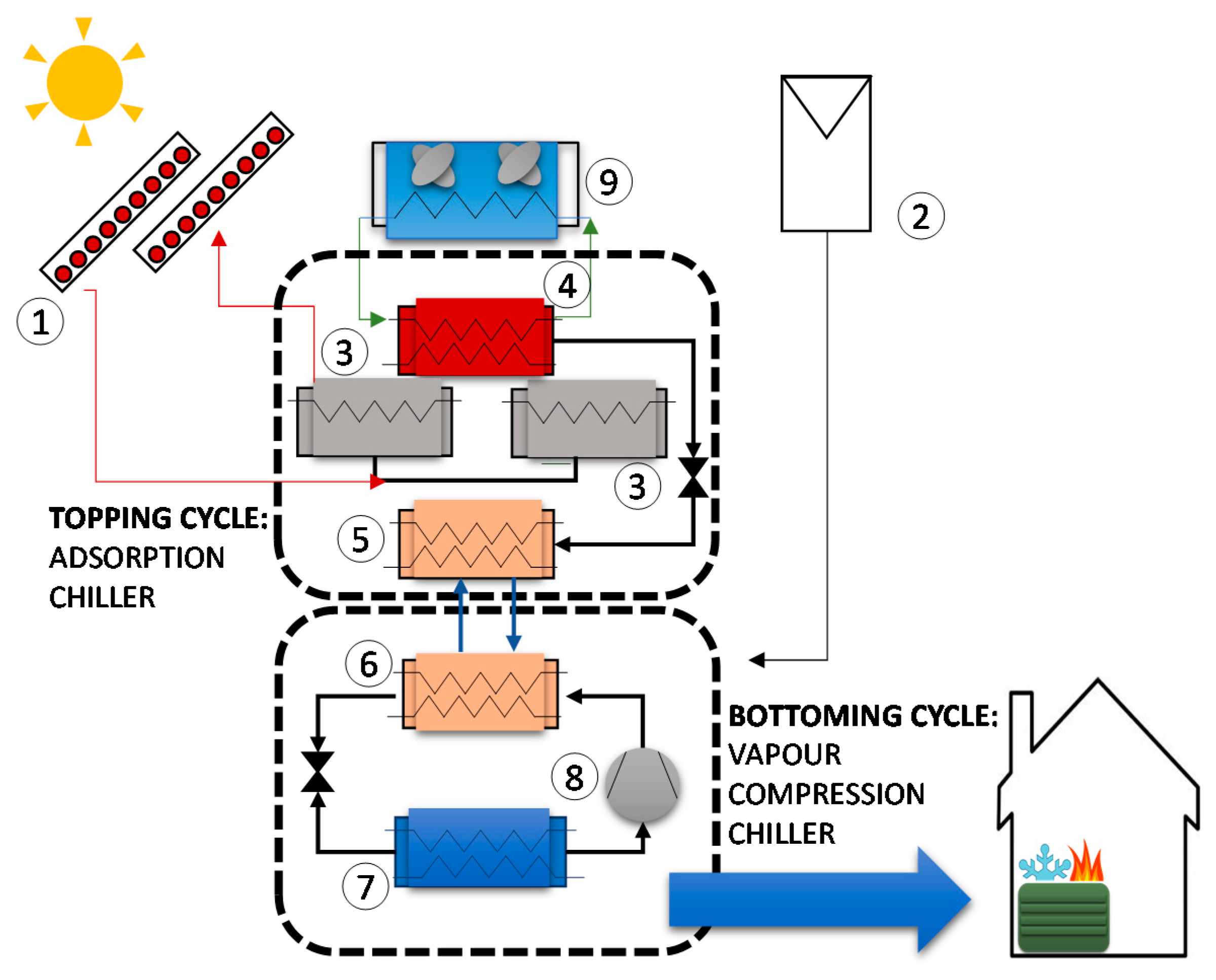
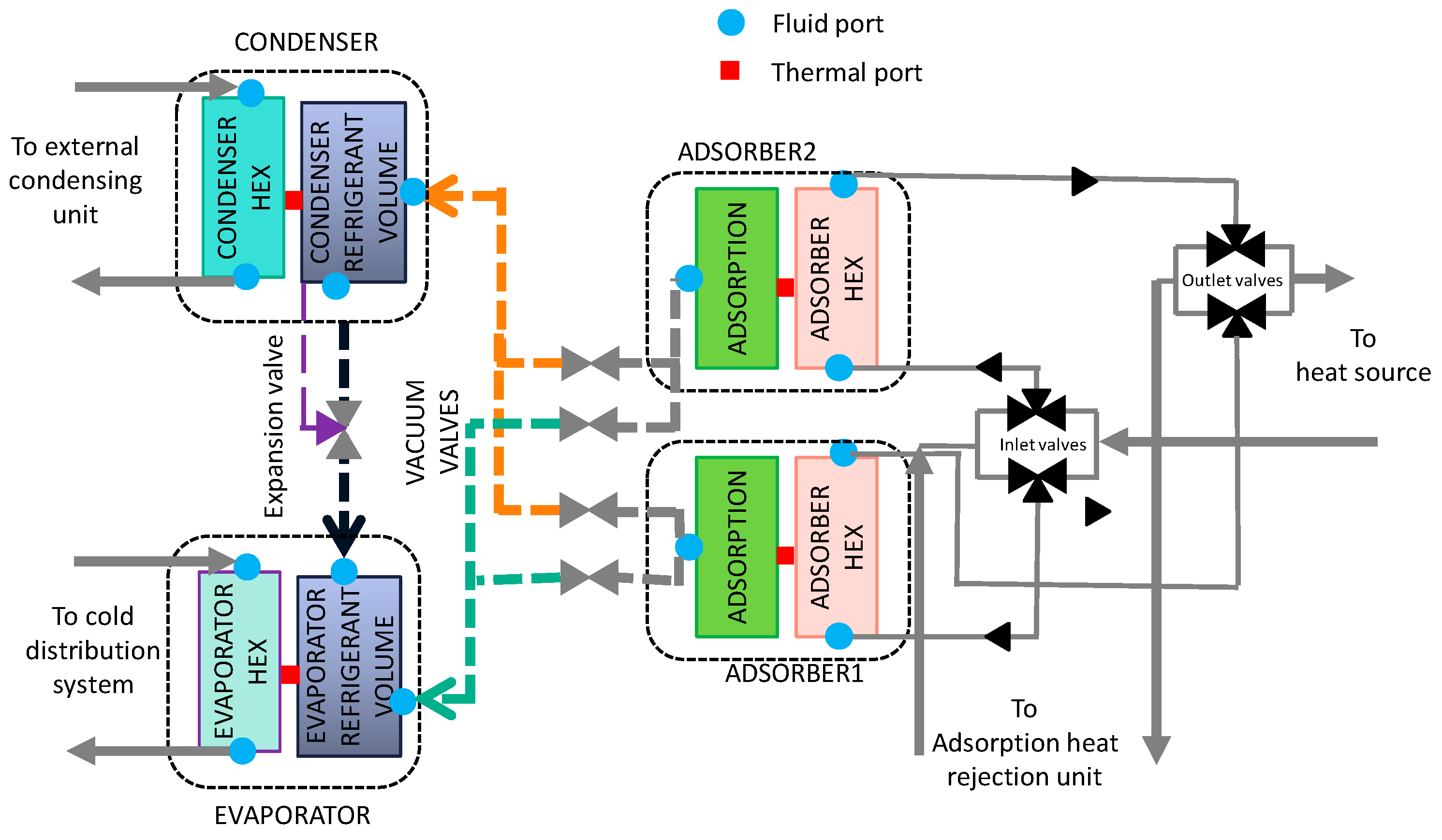
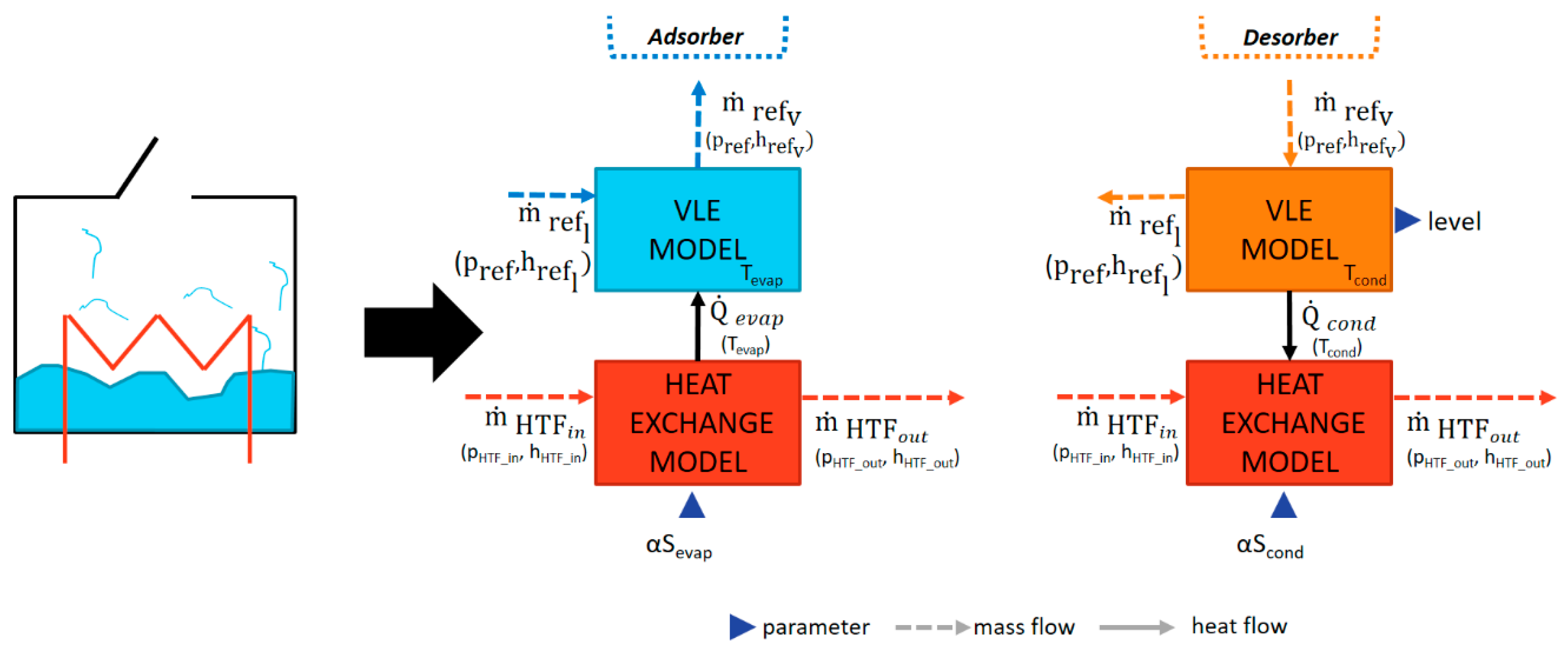
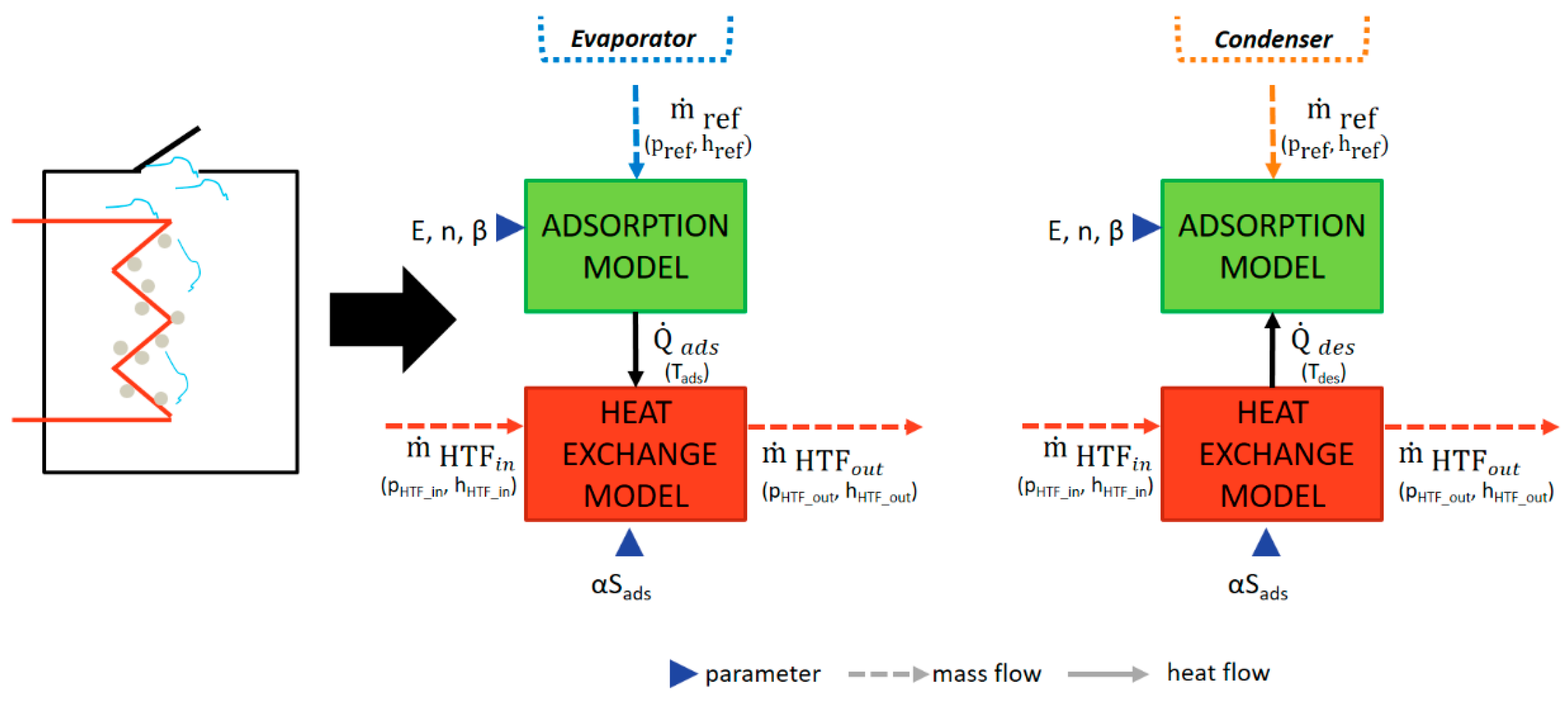
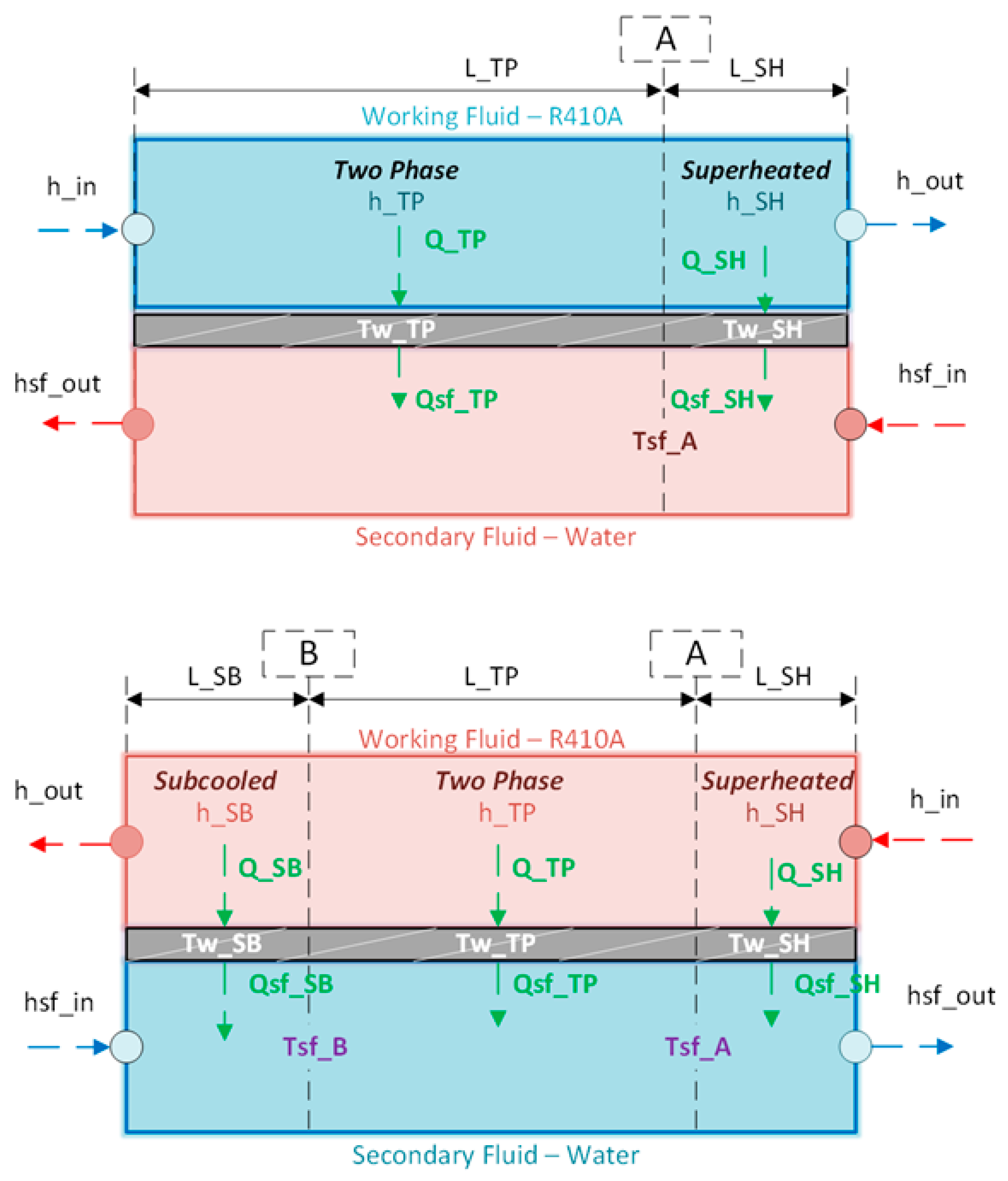
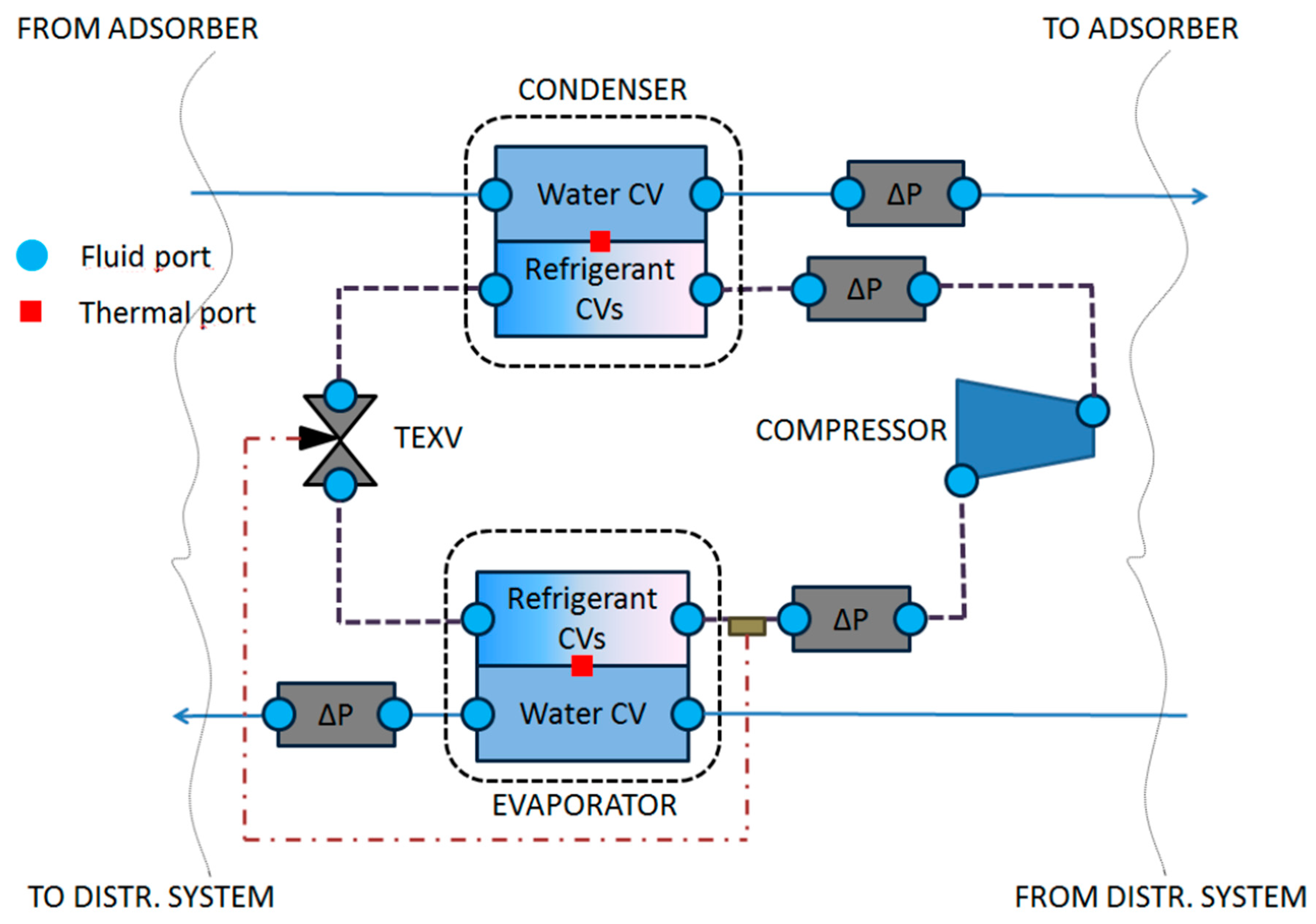
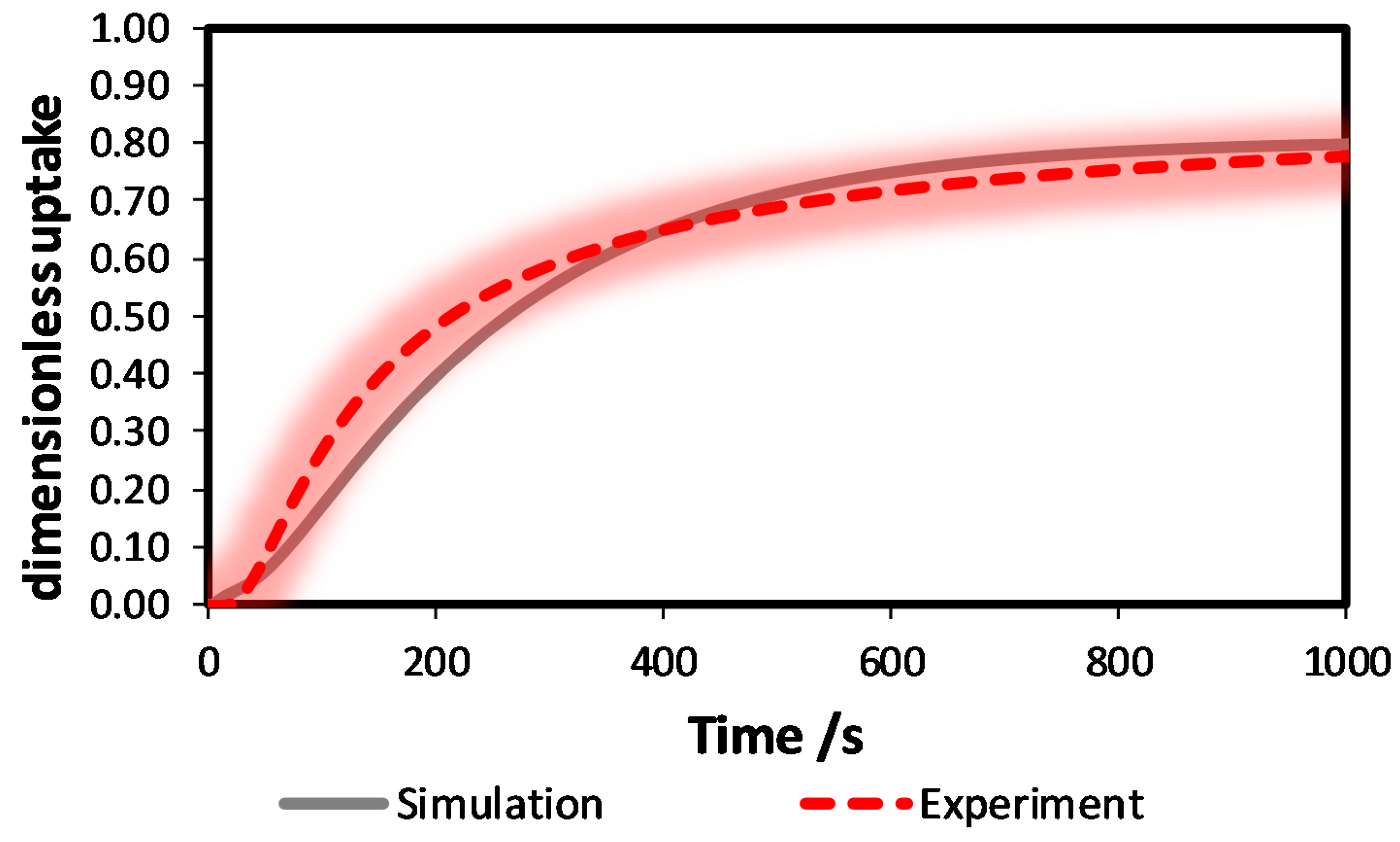
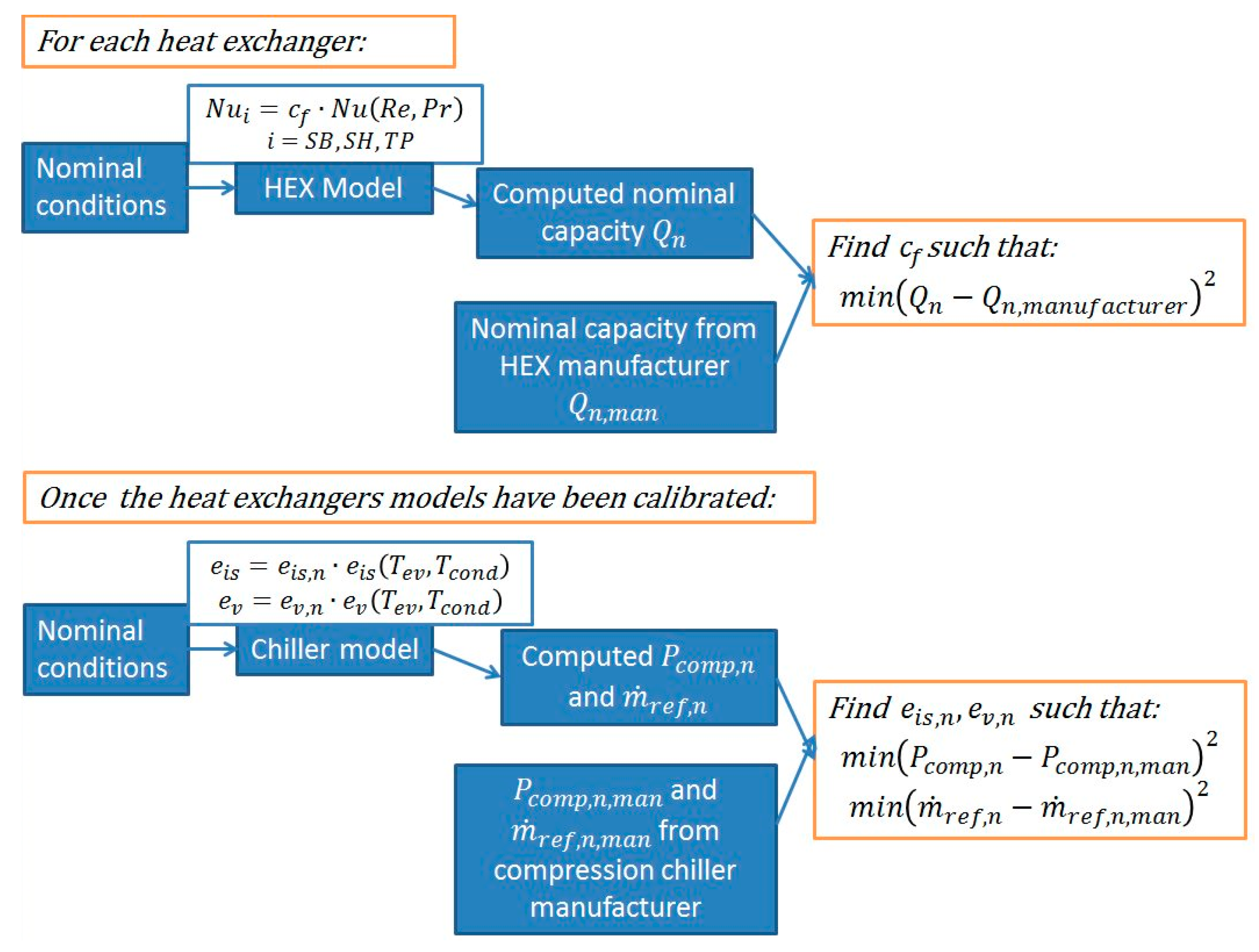
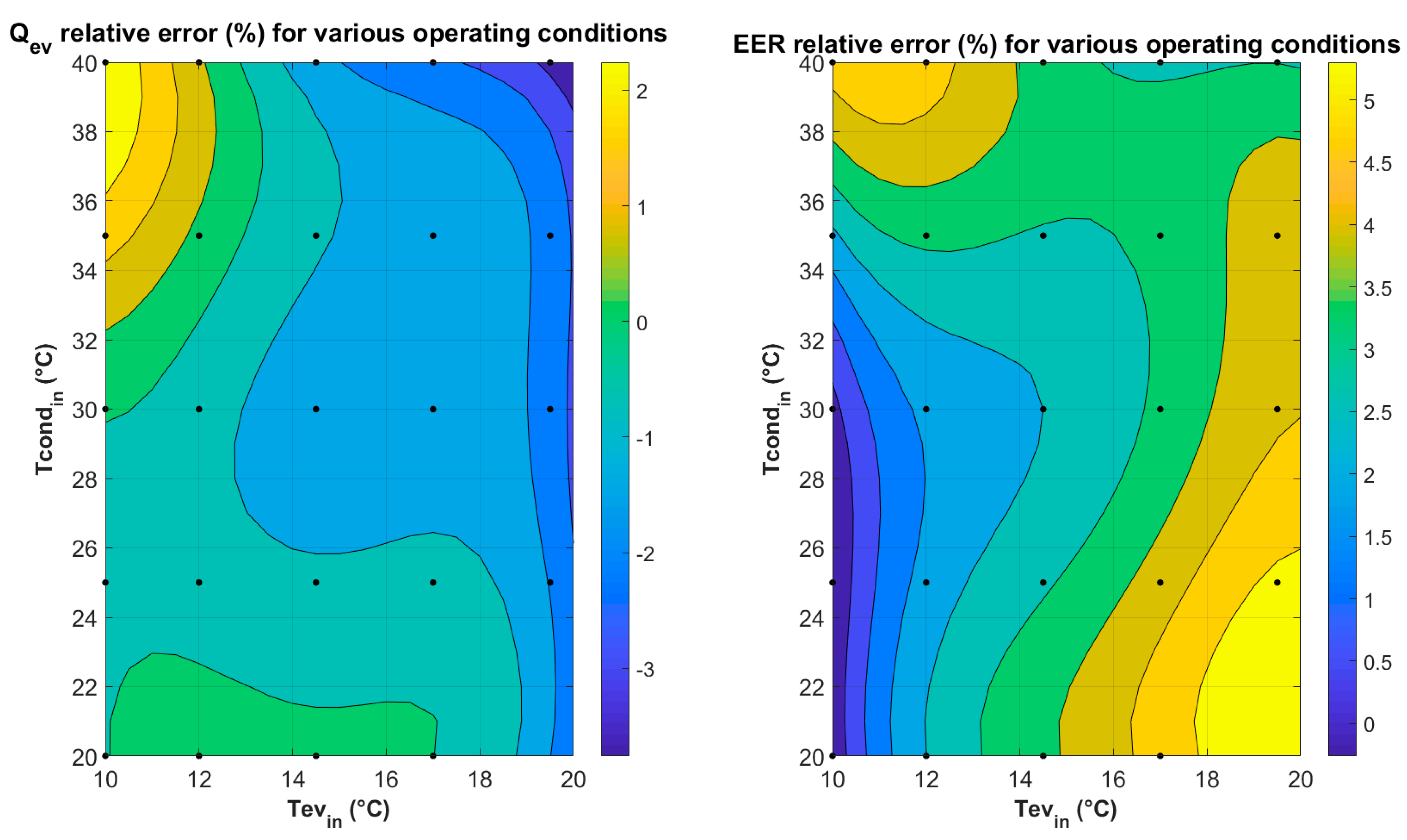
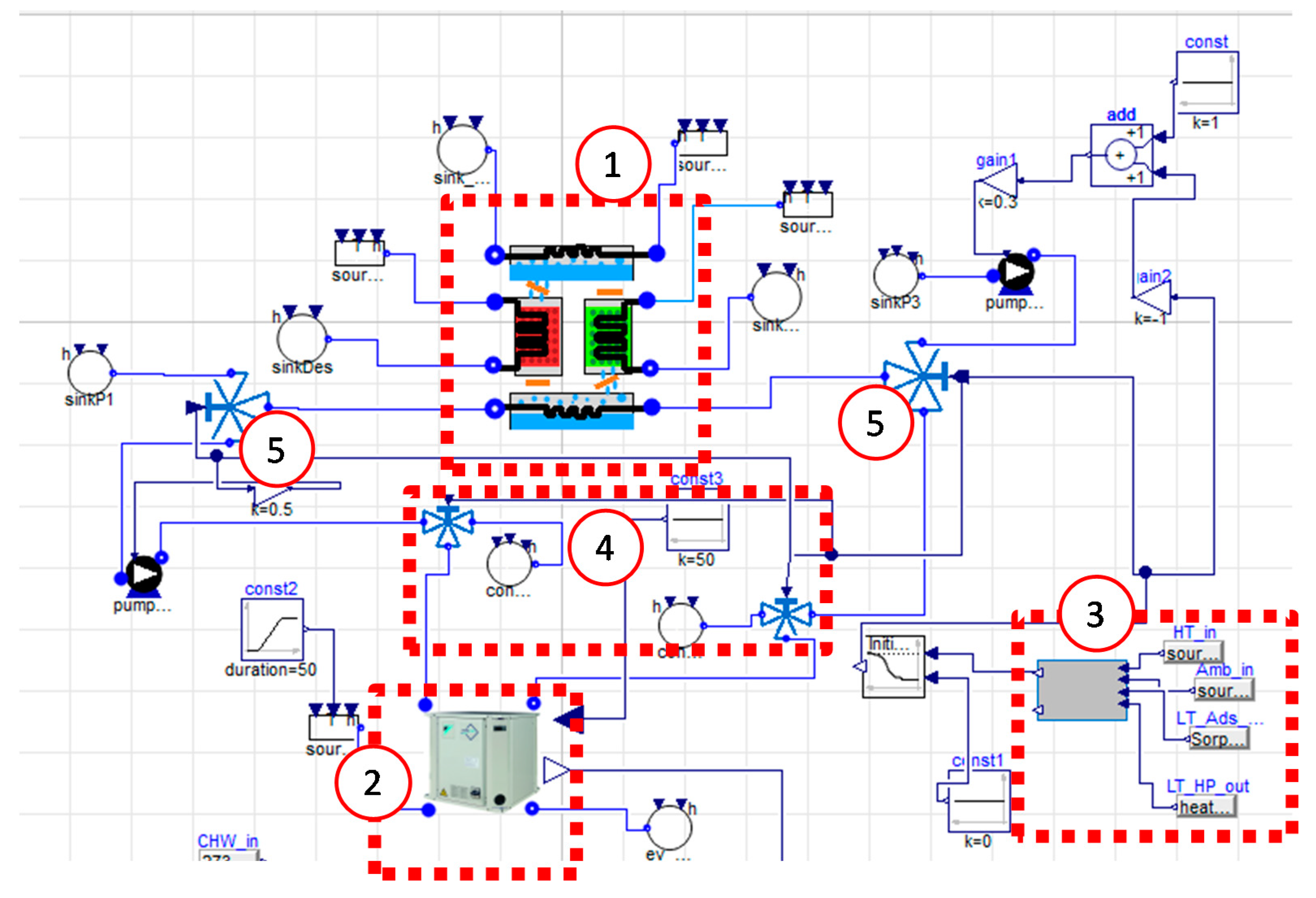
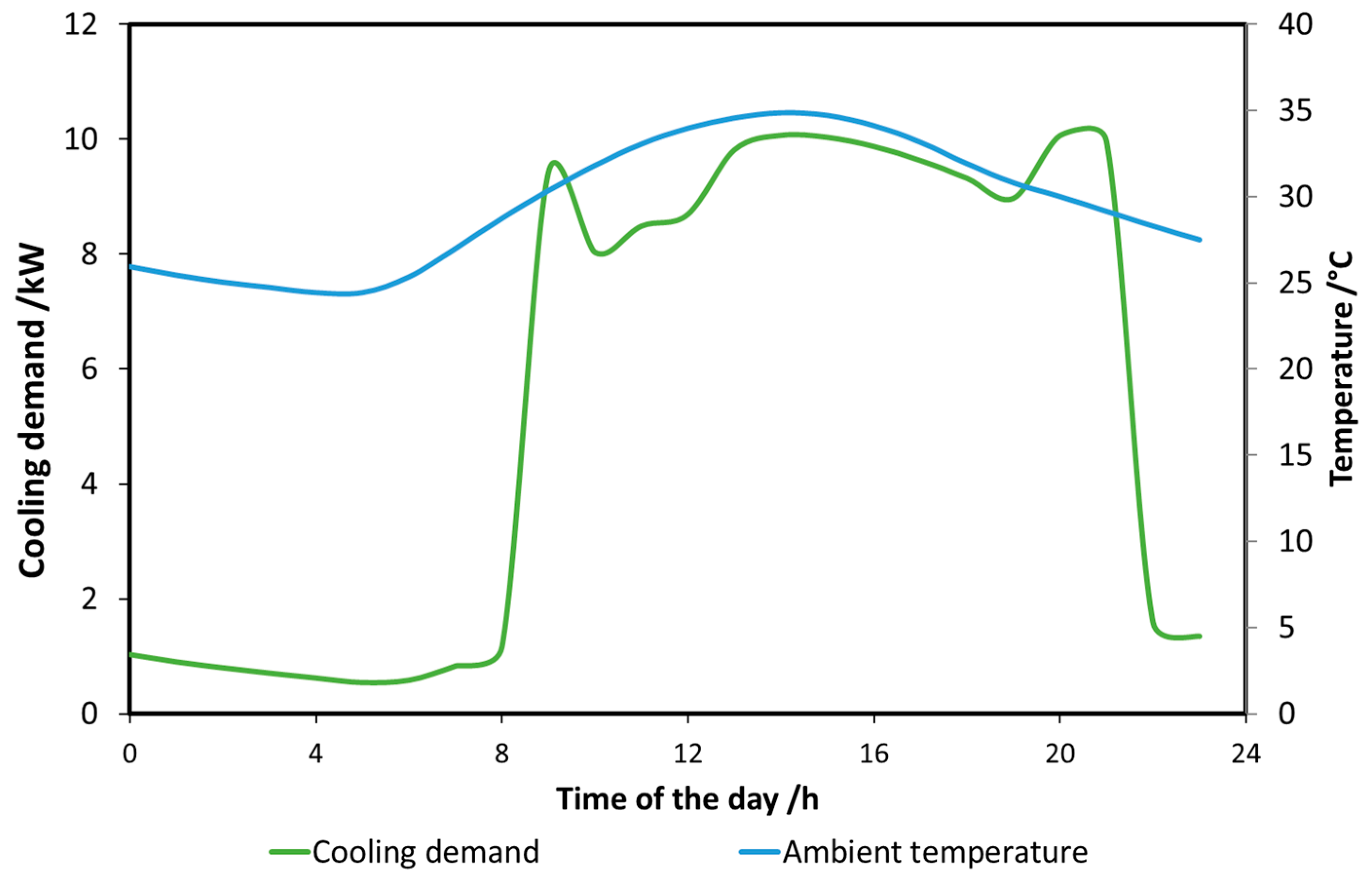
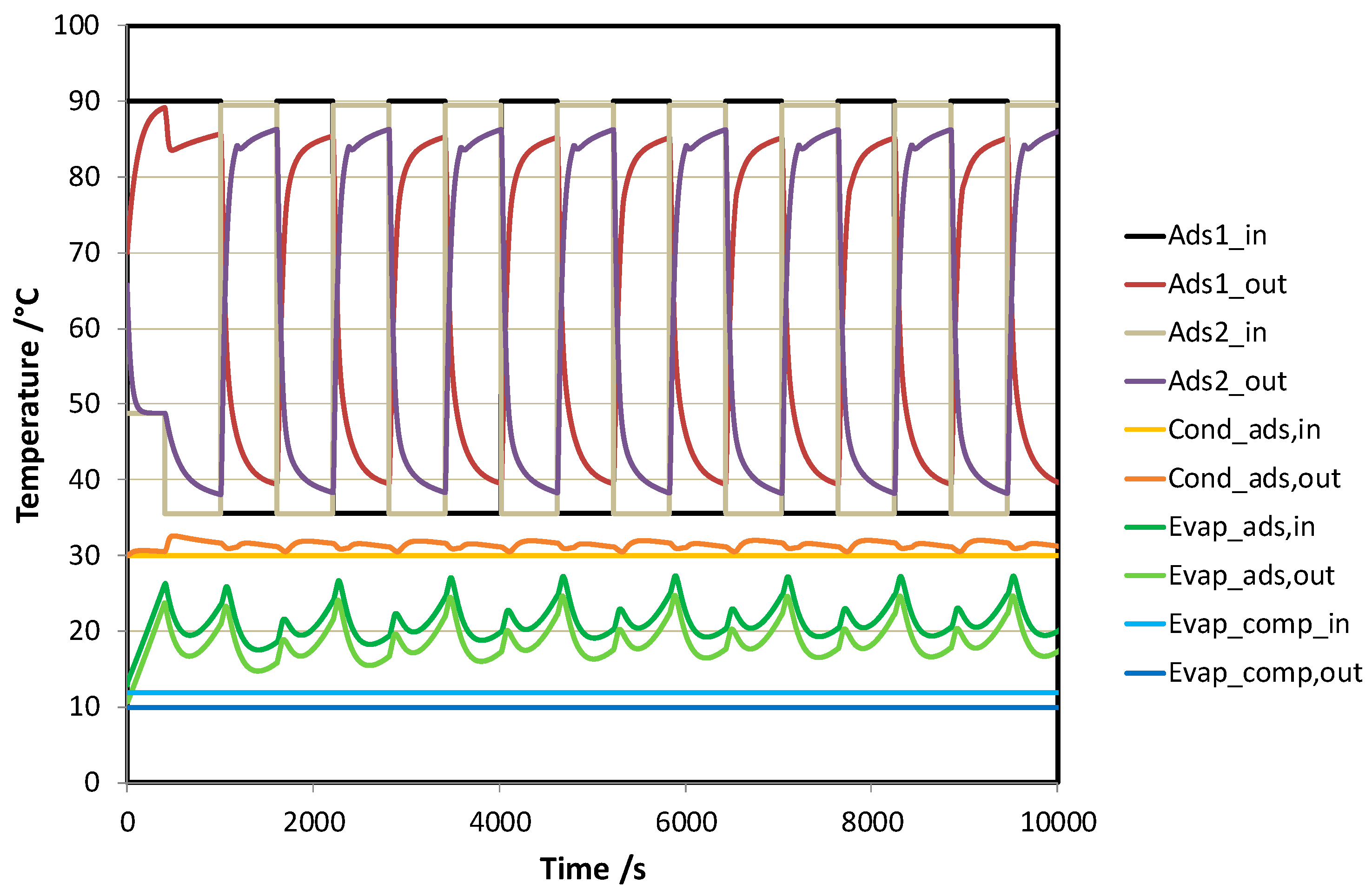
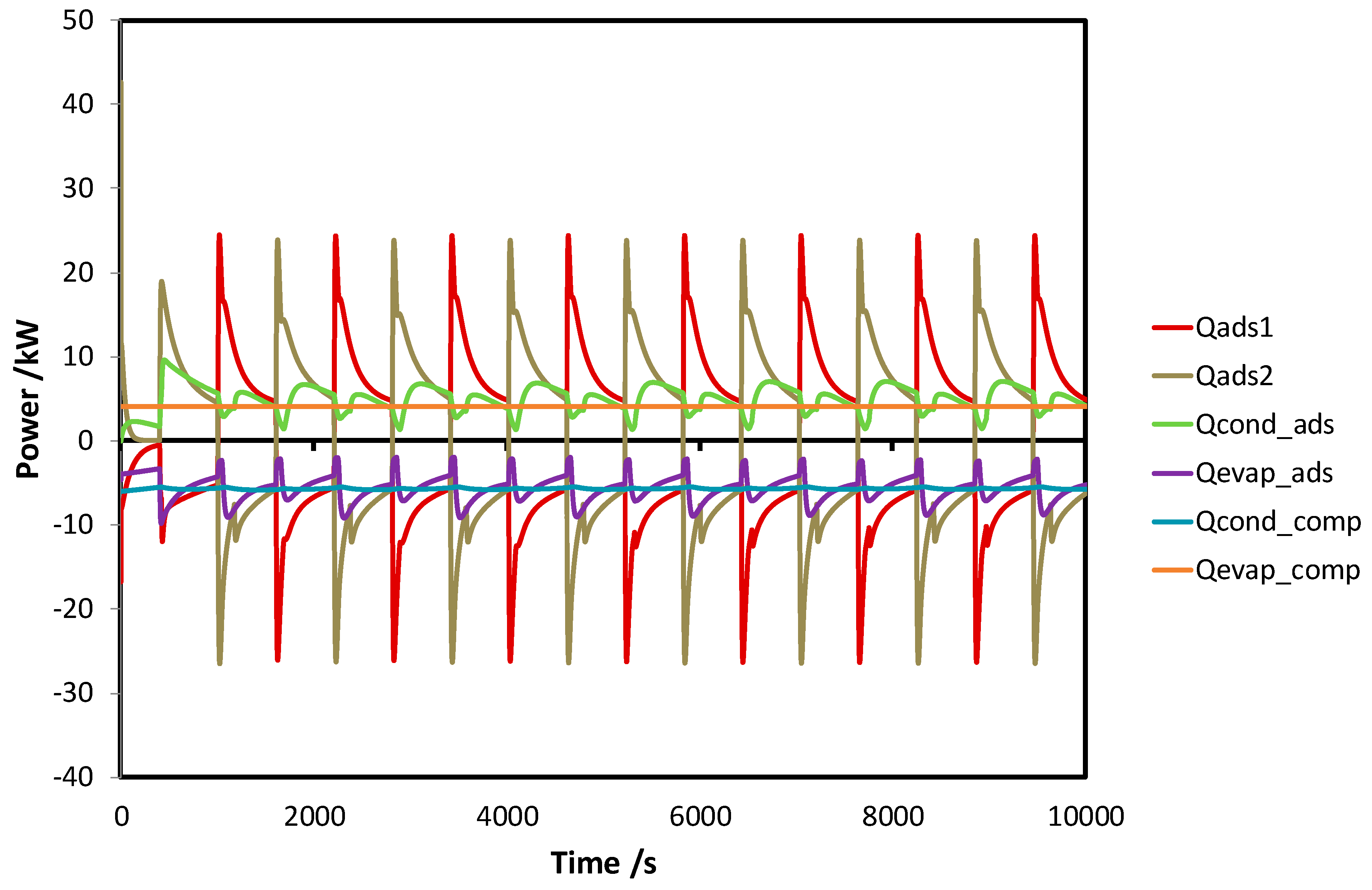

| Reference | Components/Systems Modelled | Type of Model | Simulation Tool | Validation |
|---|---|---|---|---|
| [37] | Adsorption chiller | Grey-box (coupled heat and mass transfer model of the adsorber and lumped parameters model for the other components) | COMSOL/MATLAB | Yes |
| [38,39] | Adsorber, Adsorption chiller | Physical dynamic | Modelica | Yes |
| [34] | Adsorption chiller | Physical dynamic | Modelica | Yes |
| [40] | Adsorption material | Physical dynamic | COMSOL | Yes |
| [41] | Adsorption reactor | Physical dynamic | FEMLAB | No |
| [42] | System for adsorption refrigeration-desalination | Physical dynamic | Simulink | No |
| [43] | Coated adsorber | Physical–governing equations simplified to an ODE system | Not specified | Yes, with a numerical model of a 2-bed chiller |
| [21,44,45,46,47] | Adsorption chiller | Black box | TRNSYS | Models based on experimental data or datasheets |
| [48] | Adsorption-sensible storage | Grey box | TRNSYS/MATLAB | No |
| [49] | Air-water heat pump with R410a | Physical steady-state and dynamic | Modelica | Yes |
| [50] | Air-air heat pump with R134a | Physical dynamic | Modelica | Yes |
| [32] | CO2 heat pump | Physical dynamic | Modelica | No |
| [31] | Ground-source heat pump | Physical dynamic | Modelica | Yes |
| [35] | Variable speed heat pump | Grey box | Modelica/Dymola | Yes |
| [51] | Air-water heat pump | Grey box | MATLAB/Simulink | No |
| [52] | Water-water and air-water heat pumps | Exergy modelling | - | Yes |
| [24,44] | Air-water heat pumps | Black box | TRNSYS | No |
| [25,53] | Air-water heat pumps | Black box | IDA-ICE | No |
© 2019 by the authors. Licensee MDPI, Basel, Switzerland. This article is an open access article distributed under the terms and conditions of the Creative Commons Attribution (CC BY) license (http://creativecommons.org/licenses/by/4.0/).
Share and Cite
Palomba, V.; Varvagiannis, E.; Karellas, S.; Frazzica, A. Hybrid Adsorption-Compression Systems for Air Conditioning in Efficient Buildings: Design through Validated Dynamic Models. Energies 2019, 12, 1161. https://doi.org/10.3390/en12061161
Palomba V, Varvagiannis E, Karellas S, Frazzica A. Hybrid Adsorption-Compression Systems for Air Conditioning in Efficient Buildings: Design through Validated Dynamic Models. Energies. 2019; 12(6):1161. https://doi.org/10.3390/en12061161
Chicago/Turabian StylePalomba, Valeria, Efstratios Varvagiannis, Sotirios Karellas, and Andrea Frazzica. 2019. "Hybrid Adsorption-Compression Systems for Air Conditioning in Efficient Buildings: Design through Validated Dynamic Models" Energies 12, no. 6: 1161. https://doi.org/10.3390/en12061161
APA StylePalomba, V., Varvagiannis, E., Karellas, S., & Frazzica, A. (2019). Hybrid Adsorption-Compression Systems for Air Conditioning in Efficient Buildings: Design through Validated Dynamic Models. Energies, 12(6), 1161. https://doi.org/10.3390/en12061161







